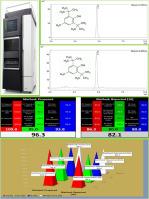A straightforward HPLC approach to testing butylated hydroxytoluene, an antioxidant, in pure and topical anti-burn gels; Evaluation of greenness, blueness, and whiteness grades
IF 3.7
Q1 CHEMISTRY, ANALYTICAL
引用次数: 0
Abstract
In lieu of being used in anti-burn gels for medicinal reasons, butylated hydroxytoluene is used as a stabilizer and antioxidant to prolong the gel's lifetime and safeguard its effectiveness by halting the oxidation and degradation of other ingredients, especially fats and oils. It shields the product's texture, color, and smell against alterations brought on by light and air exposure. Antioxidants can be used to guard the product quality during the manufacturing process only and may not need to be controlled during its shelf life. A comprehensive, rapid, clear, and environmentally friendly stability-indicating liquid chromatography (LC) technique has been developed and validated, enabling the quantification of butylated hydroxytoluene levels in topical gels. The pharmaceutical compound underwent a series of evaluations in line with ICH standards. Through isocratic separation, butylated hydroxytoluene and its associated degradants were successfully distinguished. The antioxidant was quantified and validated utilizing the Kromasil C-18 stationary phase at a temperature of 45° C. The isocratic mobile phase functions at a flow rate of 2.0 mL/min. and comprises fixed proportions of filtered water, acetonitrile, and methanol. The overall AES grade of 77, AGREE grade of 0.6, AGREEprep grade of 0.6, CACI grade of 65, AGSA grade of 63.89, MoGAPI grade of 70, BAGI grade of 77.5, and ultimate whiteness of 96.3 collectively underscore the environmental benefits of the LC method. Research suggests that the proposed approach is distinctive, accurate, reliable, robust, and ecologically advantageous, rendering it appropriate for routine quality control assessments.

一种直接的高效液相色谱方法测试纯和局部抗烧伤凝胶中的抗氧化剂丁基羟基甲苯;评价绿色、蓝色和白色等级
代替用于抗烧伤凝胶的药用原因,丁基羟基甲苯被用作稳定剂和抗氧化剂,以延长凝胶的使用寿命,并通过阻止其他成分,特别是脂肪和油的氧化和降解来保障其有效性。它可以保护产品的质地、颜色和气味不受光线和空气暴露的影响。抗氧化剂仅在生产过程中用于保护产品质量,在保质期内可能不需要控制。建立并验证了一种全面、快速、清晰、环保的稳定性指示液相色谱(LC)技术,可以定量测定外用凝胶中丁基羟基甲苯的含量。该药物化合物经过了一系列符合ICH标准的评估。通过等密度分离,成功地分离出了丁基羟基甲苯及其伴生降解物。采用Kromasil C-18固定相,在45℃的温度下对抗氧化剂进行定量和验证,等压流动相的流速为2.0 mL/min。由固定比例的过滤水、乙腈和甲醇组成。AES总等级为77,AGREE等级为0.6,AGREEprep等级为0.6,CACI等级为65,AGSA等级为63.89,MoGAPI等级为70,BAGI等级为77.5,最终白度为96.3,共同强调了LC法的环境效益。研究表明,该方法具有独特、准确、可靠、稳健和生态优势,适用于常规质量控制评估。
本文章由计算机程序翻译,如有差异,请以英文原文为准。
求助全文
约1分钟内获得全文
求助全文

 求助内容:
求助内容: 应助结果提醒方式:
应助结果提醒方式:


